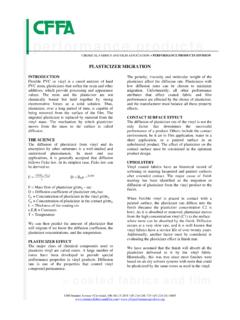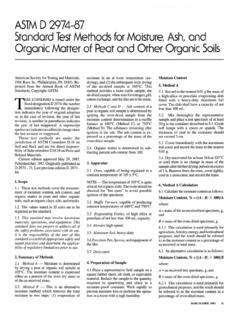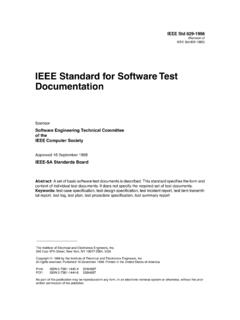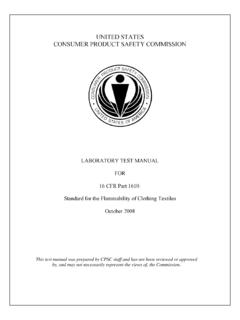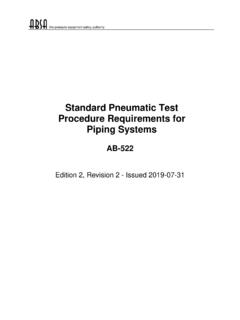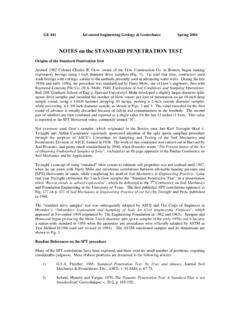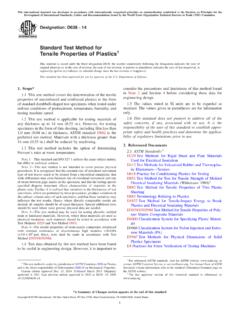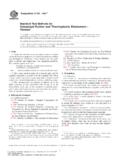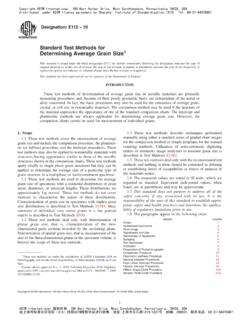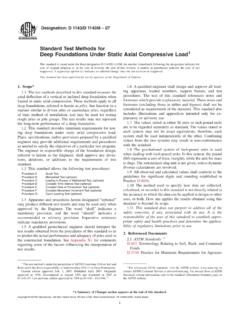Transcription of STANDARD TEST METHODS - Performance Products
1 STANDARD TEST METHODS CHEMICAL COATED FABRICS AND FILM MEMBERS BASF Corporation Flex Membrane International Corp. Canadian General-Tower Limited Formosa Plastics Corporation, USA Carlisle Construction Materials i2M CGPC America Corporation/Enduratex Morbern, Inc. Continental OMG, Inc. Duro-Last Roofing, Inc. OMNOVA Solutions ExxonMobil Chemical Company Proquinal International, Inc. FiberTite Roofing Systems Sika Sarnafil, Inc. Compiled and Issued By: 1300 Sumner Avenue Cleveland, OH 44115-2851 216-241-7333 Fax: 216-241-0105 E-Mail: URL: 2022 CHEMICAL FABRICS & FILM ASSOCIATION, INC. ALL RIGHTS RESERVED 3 FOR BETTER America s leading manufacturers and consumers use Products from Chemical Fabrics and Film members for a myriad of uses.
2 AIRCRAFT Seat backs, upholstery, wall panels and compartments. ATHLETICS & SPORTING GOODS Bowling bags, exercise mats, golf bags, gym and workout bags, tennis bags. AUTOMOTIVE & TRANSPORTATION Camper topping, convertible topping, door and console coverings, instrument panel coverings, landau tops, security shades, upholstery. EXTERIOR FILMS & LAMINATES Awnings and canopies, backlit awnings and signage, banners, outdoor decking, outdoor furniture, pond and pit liners, roofing, swimming pool liners, tents and tarpaulins. FOOTWEAR & GARMENTS Belts, jackets, protective clothing, rainwear, shoe uppers, sock linings. GRAPHIC ARTS & CASE COVERINGS Bookbinding coverstock, checkbooks, coin purses, etc., hand bags and accessories, luggage and briefcases.
3 HEALTHCARE FURNISHINGS Waiting room and lobby seating, tables, carts, storage, furniture. HOME & CONTRACT FURNISHINGS Ceiling tile facings, commercial seating, folding doors, laminating films for wood, metal and wallboard, matting, residential upholstery, window shades and blinds. MARINE Convertible topping, decking, upholstery and bolsters. MISCELLANEOUS Children safety seats, industrial tapes, juvenile furniture, mattress covers, strip doors, tank lining, toys. 4 FOREWORD This, the Tenth Edition of the STANDARD Test METHODS (STM) Pamphlet, has been prepared by the Technical Committee of the Chemical Fabrics & Film Association. These test METHODS are used by the industry and its customers to determine the physical properties of chemical coated fabrics and films, to facilitate quality control and to ensure customer satisfaction.
4 Section I covers test procedures for coated fabrics; Section II covers test procedures for fabrics and films. These tests include adhesion of coating, weight, resistance to cold, blocking, aging, abrasion resistance, hydrolytic stability, volatility, tensile, tearing strength, and many more. The purpose of each test is explained in non-technical terms, and the tests are referenced to comparable STANDARD test METHODS of the American Society for Testing and Materials, Federal Test METHODS , Specifications, and the American Association of Textile Chemists and Colorists. Section III includes terminology and customs in the Industry. Also in this section are suggestions on how to remove common stains, and the chronological history of fabric coating, and information about the Chemical Fabrics & Film Association.
5 Every effort has been made to ensure the accuracy of the information in this Pamphlet and the avoidance of excessive risks in the tests . However, the Association and those responsible for the preparation of Association publications make no representation or warranty, or assume or accept any responsibility or liability, with respect thereto. In test METHODS where a specific material, apparatus, and/or supplier is listed, please note that such a listing is for the convenience of users of the STANDARD Test METHODS . Any equipment from any supplier which produces comparable results under the testing procedure is acceptable. 5 TABLE OF CONTENTS SECTION I tests FOR CHEMICAL COATED FABRICS .. 7 STANDARD Conditions Of 7 CFFA-1: Abrasion Resistance.
6 7 a. Wyzenbeek Method .. 7 Abraser Method .. 8 CFFA-100: Accelerated Exposure To Disinfectants .. 8 CFFA-2: Accelerated Light Aging and Outdoor Weathering .. 9 a. Accelerated Lightfastness (Fadeometer or Weatherometer), Xenon Arc Indoor .. 10 b. Accelerated Weathering (Weatherometer), Xenon Arc, Outdoor .. 10 c. Fluorescent UV/Condensation Accelerated Weathering, QUV, Outdoor .. 10 d. Fluorescent UV Accelerated Light Aging, QUV, Dry Cycle, 11 CFFA-3: Adhesion Of Coating To Fabric .. 12 CFFA-300: Bacterial Resistance .. 13 CFFA-4: Blocking .. 14 CFFA-6: Cold Crack Resistance .. 14 a. Roller Method .. 14 b. Mandrel 14 CFFA-7: Crocking Resistance .. 15 a. Dry 16 CFFA-70: Denim Stain Resistance .. 15 CFFA-700: Dimensions Of Coated Fabric.
7 16 a. Width .. 16 .. 16 c. Thickness .. 16 .. 17 CFFA-8: Dry Cleanability .. 17 CFFA-9: Flame Resistance And Smoke Density .. 17 CFFA-10: Flex Resistance .. 18 CFFA-11: Hydrolytic Stability - Vinyl .. 18 CFFA-110: Hydrolytic Stability - Polyurethane .. 18 CFFA-12: Lacquer Or Varnish Lifting .. 20 CFFA-120: Mildew Resistance .. 21 CFFA-121: Pink Stain .. 21 CFFA-13: Oil Resistance .. 22 CFFA-14: Seam Strength .. 22 CFFA-140: Shrinkage .. 23 CFFA-141: Stain Resistance .. 23 CFFA-142: Stain Resistance in Healthcare Environment .. 24 CFFA-15: Stretch And Set .. 25 CFFA-16: Tearing Strength .. 26 a. Elmendorf Method .. 26 Method .. 27 c. Trapezoid Method .. 27 CFFA-17: Tensile Strength And Elongation (Also Referred To As Breaking Strength) Grab Test Method.
8 28 6 CFFA-18: Volatility .. 29 Activated Carbon Method .. 29 CFFA-19: Water Vapor Transmission .. 30 CFFA-20: Weight Of Coating And Fabric .. 31 SECTION II tests FOR CHEMICAL FABRICS AND FILMS .. 32 CFFA-200: Abrasion Resistance .. 32 a. Wyzenbeek Method .. 32 Abraser Method .. 32 CFFA-201: Blocking - Film .. 32 CFFA-202: Chlorine Resistance .. 32 CFFA-21: Density .. 33 Displacement Method .. 33 CFFA-22: Dimensional Changes At Elevated Temperatures .. 34 CFFA-220: Dimensions Of Film .. 35 CFFA-221: Lay-flat .. 35 CFFA-23: Low Temperature Impact Resistance .. 36 CFFA-240: PVC Roll Contour And Racetracking .. 36 CFFA-241: Snap Back Testing For Pool Liner Films .. 37 CFFA-25: Soapy Water Extraction .. 38 CFFA-26: Tearing Strength.
9 39 a. Graves Method .. 39 b. Elmendorf Method .. 39 CFFA-27: Tensile Properties Of Thin Plastic Sheeting .. 39 CFFA-270: Volatility .. 41 SECTION III .. 42 Terminology And Customs In The Industry .. 42 Cleaning And Care Suggestions .. 43 History of Chemical Coated Fabrics .. 45 Note: Test METHODS are listed alphabetically. Single and double digit numbers used to reference the test METHODS contained herein have not been changed from the previous editions. Three-digit numbers indicate test METHODS added to the Seventh and later Editions. 7 SECTION I tests FOR CHEMICAL COATED FABRICS STANDARD Conditions of Test Reference: ASTM D751-19- STANDARD Test METHODS for Coated Fabrics Physical tests may be made under prevailing atmospheric conditions except in the settlement of disputes.
10 Unless otherwise specified, tests shall then be made upon material in STANDARD conditions, , the condition reached when the material is in moisture equilibrium with an atmosphere having a relative humidity of 65% and temperature of 70 F (21 C). A tolerance of +/- 2% is permitted in relative humidity and +/- 2 F (1 C) in temperature. Material shall be considered to be in equilibrium when it shows no progressive change in weight after free exposure to moving air. Because of the labor involved in determining whether equilibrium has been reached, it is customary to condition the material for a minimum period of 15 hours at the temperature and relative humidity previously mentioned. Note: These conditions are STANDARD and will be used unless the test method requires special environmental conditioning.

